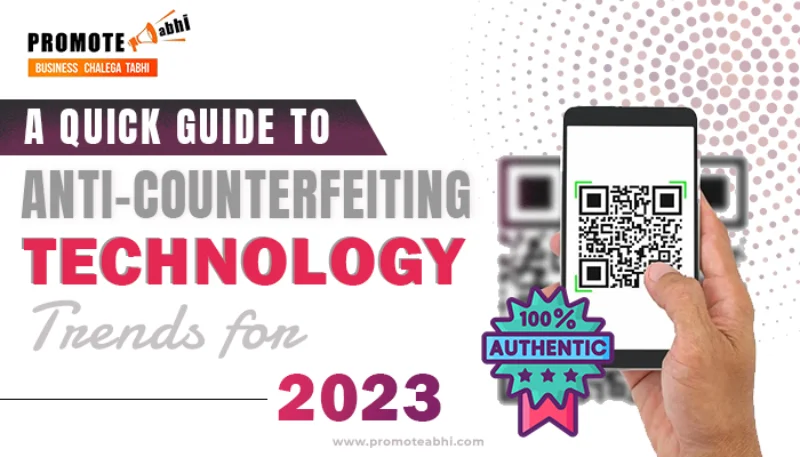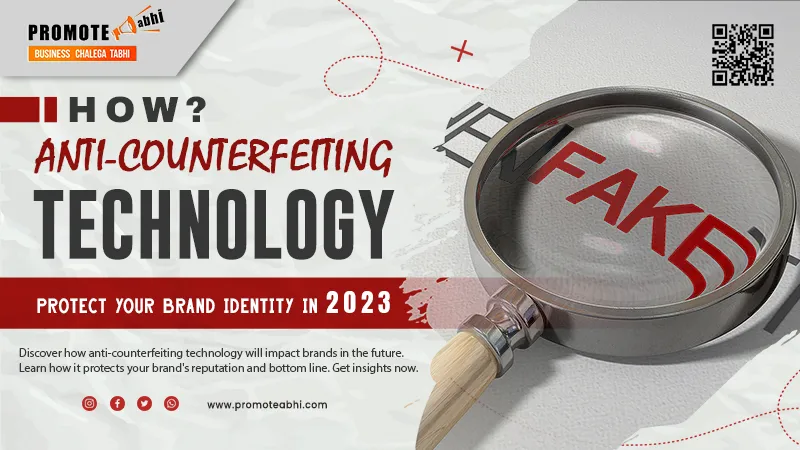In this article, we will discuss anti-counterfeiting technology solutions that businesses can use to protect their brand identities and products.
Targeting Counterfeit Prevention - How Anti-Counterfeiting Technology Works
Anti-counterfeiting technology uses various techniques to prevent and detect counterfeit products. Some of the key technologies used in anti-counterfeiting include:
Product Authentication Methods: Keeping Your Brand Secure
Product authentication methods are used to ensure that a product is genuine and has not been counterfeited. Common product authentication methods include:
- Security holograms: These holographic images are difficult to reproduce and can be used to verify the authenticity of a product.
- Serial number tracking: Unique serial numbers can be used to track a product from the manufacturer to the end-user, making it easier to identify counterfeit products.
- Barcode scanning: Barcodes can be scanned to verify the authenticity of a product and ensure that it matches the product information on the packaging.
- RFID technology: RFID tags can be used to track products and verify their authenticity.
Fraud Prevention Techniques: Staying One Step Ahead of Counterfeiters
Fraud prevention techniques are used to prevent counterfeiters from copying a product. These techniques include:
- Tamper-evident features: These features make it obvious if a product has been tampered with, making it more difficult for counterfeiters to copy the product.
- Secure printing methods: Secure printing methods, such as using special inks or printing techniques, can make it more difficult for counterfeiters to copy a product.
- Digital watermarking: Digital watermarks can be used to embed invisible codes in a product's packaging or label, making it easier to identify counterfeit products.
Brand Protection Technology - Protecting Your Business and Customers
Brand protection technology is designed to protect businesses and their customers from counterfeit products. Some of the key brand protection technologies include:
Security Printing Methods: Preventing Counterfeiting through Print Technology
Security printing methods are used to prevent counterfeiters from copying a product's packaging or label. Some common security printing methods include:
- Holographic images: These images are difficult to copy and can be used to verify the authenticity of a product.
- Microprinting: Tiny text or images can be printed on a product's packaging or label, making it more difficult for counterfeiters to copy the product.
- Watermarking: Watermarks can be used to identify authentic products and prevent counterfeiters from copying the product.
Supply Chain Security: Tracing Your Products from Production to Sale
Supply chain security is important for preventing counterfeit products from entering the market. By tracking a product from production to sale, businesses can identify any potential issues in the supply chain that could lead to counterfeit products. Some common supply chain security methods include:
- Serial number tracking: Unique serial numbers can be used to track a product from the manufacturer to the end-user.
- RFID technology: RFID tags can be used to track products throughout the supply chain, making it easier to identify counterfeit products.
Brand Reputation Management: Maintaining Brand Integrity and Trust
Brand reputation management is important for maintaining customer trust and preventing counterfeit products from damaging a brand's reputation. Some common brand reputation management techniques include:
- Regular communication with customers: Regular communication with customers can help to build trust and prevent counterfeit products from damaging a brand's reputation.
- Anti-counterfeit campaigns: Anti-counterfeit campaigns can help to raise awareness of counterfeit products and encourage customers to purchase authentic products.
Anti-Counterfeit Packaging - Securing Your Products from Counterfeiters
One of the most effective ways to prevent counterfeiting is through the use of anti-counterfeit packaging. Anti-counterfeit packaging refers to packaging designs and materials that make it difficult for counterfeiters to reproduce or replicate.
There are several types of anti-counterfeit packaging solutions available, such as tamper-evident features, security holograms, and serial number tracking. Tamper-evident features, such as seals or tapes, are used to indicate if a package has been opened or tampered with.
- Security holograms are labels that feature a holographic design that is difficult to replicate, providing an added layer of security.
- Serial number tracking allows manufacturers to track a product from production to distribution to help identify any counterfeit products.
Digital Watermarking: Embedding Invisible Codes for Product Verification
Digital watermarking is a technique that involves embedding an invisible code into a product or its packaging to help verify its authenticity. This code can be scanned using specialized software or mobile applications to confirm that the product is genuine.
Digital watermarking is a highly effective solution for preventing counterfeiting, as the code is virtually impossible to replicate. Additionally, digital watermarking can be used to track a product throughout its entire supply chain, making it an invaluable tool for brand owners and manufacturers.
Learn more: Why Your Business Needs an Offer/coupon Management Software?
Blockchain Technology: Creating a Secure and Transparent Supply Chain
Blockchain technology is a decentralized digital ledger that provides a secure and transparent way to track transactions. By using blockchain technology, manufacturers and brand owners can create a secure and transparent supply chain that makes it difficult for counterfeiters to infiltrate.
One of the key benefits of blockchain technology is its ability to create a permanent and unalterable record of all transactions. This provides an added layer of security, as any attempt to alter or tamper with the record would be immediately detected. Additionally, blockchain technology can be used to track a product's entire supply chain, from production to distribution to final sale.
Mobile Authentication: Verifying Products through Mobile Devices
Mobile authentication is a technology that allows consumers to verify the authenticity of a product using their mobile device. This technology typically involves scanning a code or image on the product or its packaging to confirm that it is genuine.
Mobile authentication is a highly effective solution for preventing counterfeiting, as it provides an easy and convenient way for consumers to verify the authenticity of a product. Additionally, mobile authentication can be used to track a product's entire supply chain, providing added security and transparency.
Also, Visit here: B2B Coupon Management Software for Your Business
Forensic Analysis Techniques - Uncovering Counterfeits with Science
Forensic analysis is the application of scientific methods to investigate and solve crimes. In the context of counterfeiting, forensic analysis techniques can help identify counterfeit products and their sources. Some of the forensic analysis techniques used in anti-counterfeiting include:
- Microscopic analysis: Microscopic analysis involves examining the physical features of a product using a microscope. This technique can help identify inconsistencies in the texture, color, and overall appearance of a product that may indicate counterfeiting.
- Spectroscopy: Spectroscopy is a technique that involves analyzing the interaction between light and matter to identify the chemical composition of a product. This technique can help identify the presence of unauthorized substances or variations in composition that may indicate counterfeiting.
- DNA analysis: DNA analysis is a technique that involves identifying the unique genetic code of a product to determine its authenticity. This technique is commonly used in the pharmaceutical industry to identify counterfeit drugs.
- X-ray diffraction: X-ray diffraction involves analyzing the crystal structure of a product using X-rays to identify its composition and properties. This technique is commonly used to identify counterfeit gemstones.
Forensic analysis techniques can be effective in identifying counterfeit products and their sources, but they require specialized equipment and expertise.
Secure Document Printing: Protecting Sensitive Documents from Forgery
Secure document printing is an effective way to prevent forgery and protect sensitive documents, such as passports, visas, and banknotes. The following are some of the security features used in secure document printing:
- Holograms: Holograms are three-dimensional images that can be incorporated into a document to provide a visual representation of authenticity. They are difficult to replicate and provide an added layer of security.
- Watermarks: Watermarks are images or patterns that are visible when a document is held up to light. They are difficult to replicate and provide a visual representation of authenticity.
- Tamper-evident features: Tamper-evident features, such as security seals and tear-resistant materials, are designed to indicate if a document has been tampered with or altered.
- Serial numbers: Serial numbers can be used to track and verify the authenticity of a document. They can be incorporated into the document design or added as a separate feature.
- Microprinting: Microprinting involves printing small text or images that are difficult to replicate. It can be used to add an additional layer of security to a document.
Secure document printing can help prevent forgery and protect sensitive documents from unauthorized reproduction or alteration.
Anti-Piracy Measures: Preventing Copyright Infringement and Piracy
Piracy is another form of counterfeiting that involves the unauthorized reproduction and distribution of copyrighted materials, such as music, movies, and software. Piracy not only hurts the creators and owners of the original material but also poses a significant threat to consumers who may unknowingly download or use pirated software or content, which can contain viruses and other harmful software.
To prevent piracy, businesses can use digital rights management (DRM) technologies, which control the use, modification, and distribution of digital content. DRM technologies use encryption and access control mechanisms to protect copyrighted materials and prevent unauthorized use and distribution.
Read more at: What Is Customer Loyalty Program Software and How Does It Work?
Authenticity Verification Solutions: Ensuring Your Products Are Genuine
Authenticity verification solutions use various technologies to verify the authenticity of a product, such as anti-counterfeit labels, authentication technology, and RFID technology. Anti-counterfeit labels are physical labels or markings on a product that are difficult to replicate, such as holograms, watermarks, and tamper-evident features. These labels can help consumers and authorities identify genuine products and prevent the sale of counterfeit goods.
Authentication technology, such as barcode scanning and serial number tracking, can also help verify the authenticity of a product. These technologies allow consumers to scan or enter a unique code to confirm the product's origin and authenticity. RFID technology can also be used for authentication, as it allows businesses to track and verify the movement of goods throughout the supply chain.
Conclusion
Counterfeiting is a serious problem that affects businesses and consumers worldwide. Fortunately, there are various anti-counterfeiting technologies and solutions available to prevent the production, distribution, and sale of fake products.
By implementing these technologies and strategies, businesses can protect their brands and consumers from the dangers of counterfeiting.


















Comments